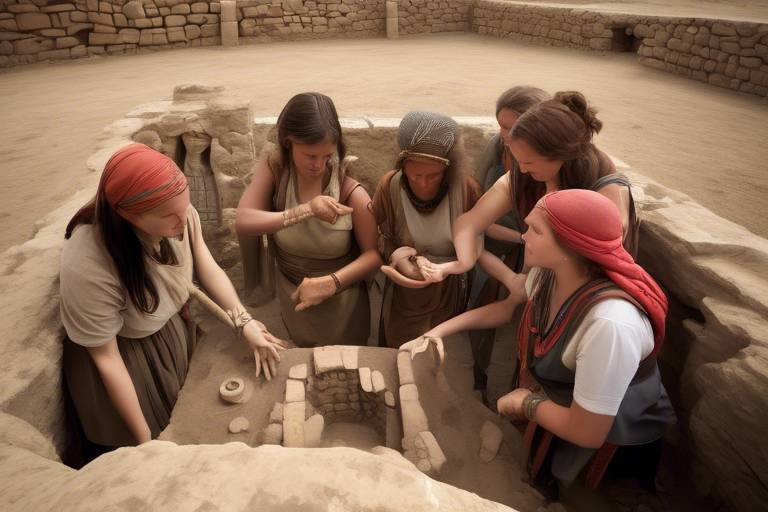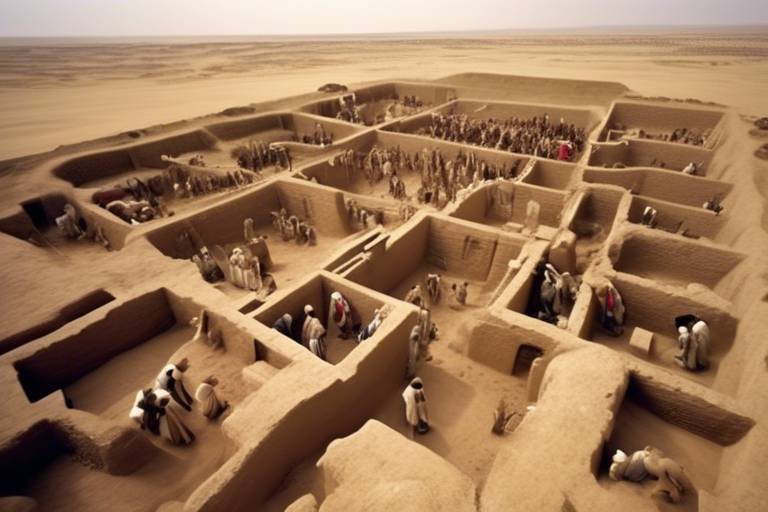The Role of Artificial Intelligence in Archaeological Research
Artificial Intelligence (AI) is revolutionizing the field of archaeological research, bringing forth a new era of exploration and discovery. By harnessing the power of AI technologies, archaeologists are able to delve deeper into the mysteries of ancient civilizations, uncovering hidden treasures and unraveling the secrets of the past. Let's dive into how AI is transforming the way we approach archaeological studies.

Enhanced Data Analysis
Exploring how AI is revolutionizing archaeological research by enhancing data analysis, site mapping, artifact identification, and predictive modeling, ultimately leading to new discoveries and insights into ancient civilizations.
AI algorithms are streamlining the analysis of vast archaeological datasets, enabling researchers to uncover patterns, trends, and correlations that may have been overlooked using traditional methods. By harnessing the power of machine learning, AI can process immense amounts of data at a speed and scale that surpass human capabilities. This allows archaeologists to delve deeper into the information gathered from excavations, identifying subtle connections and nuances that could reveal hidden stories of ancient societies.

Site Mapping and Reconstruction
When it comes to archaeological research, the role of AI in site mapping and reconstruction cannot be overstated. Imagine having the ability to virtually reconstruct ancient structures and landscapes with incredible detail and accuracy, all thanks to artificial intelligence. Through the use of AI-powered tools, archaeologists are now able to create 3D models and detailed site maps that provide a deeper understanding of the past.
These advanced technologies not only allow researchers to visualize ancient sites in a whole new light but also aid in preserving and documenting these historical locations for future generations. By leveraging AI, archaeologists can uncover hidden details and gain insights into the layout and organization of ancient civilizations that were previously unimaginable.
Moreover, the speed and precision at which AI can process and analyze data significantly accelerates the mapping and reconstruction process. What might have taken years to manually map out can now be accomplished in a fraction of the time, freeing up researchers to focus on interpretation and analysis.
Imagine being able to virtually walk through a long-lost city or temple, experiencing the grandeur and complexity of these ancient structures as if you were truly there. AI is making this possible, revolutionizing how archaeologists study and interact with the past.

Artifact Identification
When it comes to , the integration of AI and machine learning has revolutionized the way archaeologists analyze and classify ancient objects. By harnessing the power of AI algorithms, researchers can now swiftly identify and categorize artifacts, pottery fragments, and various archaeological findings. This not only accelerates the cataloging process but also plays a crucial role in the preservation of cultural heritage.
Imagine a scenario where a team of archaeologists unearths a collection of artifacts from a dig site. In the past, identifying and documenting each piece would have been a time-consuming and labor-intensive task. However, with the assistance of AI, the process becomes efficient and accurate. The technology can quickly recognize patterns, shapes, and characteristics, providing valuable insights into the historical significance of each item.
Moreover, AI's ability to learn and adapt from new data sets enhances its accuracy over time. As more artifacts are identified and classified, the AI system becomes increasingly proficient in recognizing similar objects in the future. This continuous learning process not only speeds up the identification process but also contributes to the overall advancement of archaeological research.
By leveraging AI for artifact identification, archaeologists can delve deeper into the past, uncovering hidden stories and connections that may have remained undiscovered using traditional methods. The synergy between human expertise and AI technology opens up a world of possibilities, allowing researchers to piece together the puzzle of ancient civilizations with greater precision and insight.

Predictive Modeling
When it comes to the field of archaeology, the role of Artificial Intelligence (AI) in predictive modeling cannot be understated. AI algorithms have the remarkable ability to analyze vast amounts of environmental data, historical records, and geographical features to predict potential archaeological sites with a high degree of accuracy. By leveraging AI technology, researchers are able to focus their efforts on areas that have a higher probability of uncovering significant discoveries, saving time and resources in the process.
Imagine AI as a skilled detective, sifting through intricate clues and patterns in the data to pinpoint where ancient civilizations may have left their mark. These predictive models act as a guiding light for archaeologists, leading them on a journey of exploration and discovery to unveil the mysteries of the past. By harnessing the power of AI in predictive modeling, researchers are equipped with a valuable tool that enhances their ability to make groundbreaking archaeological findings.
Moreover, AI's predictive modeling capabilities extend beyond just identifying potential sites. These advanced algorithms can also assist in determining the most effective excavation strategies, optimizing the allocation of resources, and even forecasting how environmental changes may impact archaeological sites in the future. It's like having a crystal ball that offers insights into the past and future simultaneously, revolutionizing the way archaeological research is conducted.
Through the integration of AI in predictive modeling, archaeologists are not only uncovering hidden treasures of ancient civilizations but also reshaping the landscape of archaeological exploration. By combining human expertise with AI intelligence, the possibilities for new discoveries and insights into our rich cultural heritage are endless.

Virtual Reality Applications
Virtual reality (VR) applications in archaeology are revolutionizing the way researchers interact with ancient sites and artifacts. By combining AI technology with immersive VR experiences, archaeologists can delve into the past like never before. These applications allow experts to virtually explore archaeological sites in intricate detail, providing a 360-degree view of ancient structures and landscapes.
Through VR, researchers can visualize historical contexts in real-time, gaining a deeper understanding of how ancient civilizations lived and interacted with their environment. The ability to walk through virtual reconstructions of historical sites offers a unique perspective that traditional methods cannot replicate.
Furthermore, VR applications enhance collaboration among archaeologists by enabling them to share virtual experiences and findings across different locations. This fosters a sense of teamwork and allows experts from around the world to work together seamlessly on archaeological projects.

Language Translation and Analysis
Language Translation and Analysis in archaeology has been significantly transformed by the integration of Artificial Intelligence (AI) technology. By harnessing the power of AI-powered translation tools, archaeologists can now decipher ancient texts and inscriptions with greater efficiency and accuracy. These tools break down language barriers that have long hindered the understanding of past civilizations, enabling researchers to unlock valuable insights and historical context that were previously inaccessible.
Imagine being able to translate ancient hieroglyphics or decipher lost languages from archaeological artifacts in a matter of seconds, thanks to AI algorithms. This rapid translation capability not only speeds up the analysis process but also opens up new possibilities for understanding the cultural and linguistic nuances of ancient societies. AI is essentially acting as a bridge between modern researchers and the voices of the past, allowing for a deeper exploration of historical narratives.
Moreover, AI-driven language analysis tools are revolutionizing the way archaeologists interpret ancient manuscripts and documents. By scanning and analyzing vast amounts of text, AI can identify patterns, linguistic structures, and contextual meanings that may have eluded human researchers. This enhanced analysis not only aids in the translation process but also sheds light on the social, political, and religious aspects of ancient civilizations.
Through AI, archaeologists can now delve into the intricacies of ancient languages and texts with a level of precision and speed that was previously unimaginable. The ability to quickly translate, analyze, and interpret linguistic artifacts is paving the way for groundbreaking discoveries and a deeper understanding of the rich tapestry of human history.

Cultural Heritage Preservation
When it comes to , the role of artificial intelligence is paramount in safeguarding our rich historical legacy. AI systems are playing a crucial role in monitoring and detecting potential threats to archaeological sites, aiding in the protection of these invaluable cultural treasures. By utilizing advanced technologies such as drones and satellite imaging, AI can identify unauthorized excavations, looting activities, vandalism, and environmental degradation that pose risks to archaeological sites.
Moreover, AI algorithms can analyze vast amounts of data to predict potential threats and vulnerabilities, enabling proactive measures to be taken to prevent damage to cultural heritage sites. By continuously monitoring these sites in real-time, AI systems provide archaeologists and conservationists with timely alerts and insights, allowing for swift intervention to mitigate risks and ensure the preservation of our shared history.
Furthermore, AI's ability to process and interpret complex data sets helps in developing strategies for sustainable conservation practices. By identifying patterns of deterioration and assessing the impact of various factors on archaeological sites, AI contributes to the implementation of effective preservation techniques that prolong the lifespan of cultural artifacts and structures.

Public Engagement and Education
Public engagement and education in archaeology have been significantly transformed by the integration of Artificial Intelligence (AI) technologies. Through interactive apps, virtual tours, and educational platforms, AI is revolutionizing the way people interact with and learn about ancient history. By leveraging AI-driven tools, archaeologists can now offer the public immersive experiences that bring the past to life in ways never before possible.
Imagine being able to explore a virtual reconstruction of an ancient city, walk through its streets, and witness daily life as it once was. With AI and virtual reality technologies, this experience is becoming a reality. These innovative tools not only make archaeology more accessible but also engage a wider audience by creating interactive and visually captivating experiences.
Furthermore, AI-powered educational platforms are enhancing learning opportunities by providing in-depth insights into archaeological discoveries and historical contexts. Students and enthusiasts can now delve into the intricacies of ancient civilizations through interactive lessons, 3D models, and real-time simulations.
By bridging the gap between the past and the present, AI is fostering a deeper appreciation for cultural heritage and archaeological research. Through engaging and educational initiatives, the public is not only learning about ancient civilizations but also actively participating in the preservation and exploration of our shared human history.
Frequently Asked Questions
- How is AI improving data analysis in archaeology?
AI algorithms are enhancing data analysis in archaeology by efficiently processing large datasets to reveal patterns and correlations that traditional methods might miss. This leads to a deeper understanding of ancient civilizations.
- What role does AI play in artifact identification?
AI, through machine learning, accelerates artifact identification and classification processes, aiding in cataloging artifacts and preserving cultural heritage. It speeds up the identification of pottery fragments and other objects.
- How does AI contribute to predictive modeling in archaeology?
AI algorithms predict potential archaeological sites by analyzing environmental data, historical records, and geographical features. This assists researchers in focusing their efforts on areas with higher chances of significant discoveries.
- What is the significance of AI in cultural heritage preservation?
AI systems help in monitoring and detecting threats to archaeological sites, such as looting and vandalism, contributing to the preservation of cultural heritage. They play a crucial role in preventing environmental damage to these sites.
- How does AI enhance public engagement with archaeology?
AI revolutionizes public engagement by offering interactive apps, virtual tours, and educational platforms that make ancient history more accessible and engaging to a wider audience. It provides immersive experiences and educational tools.


















